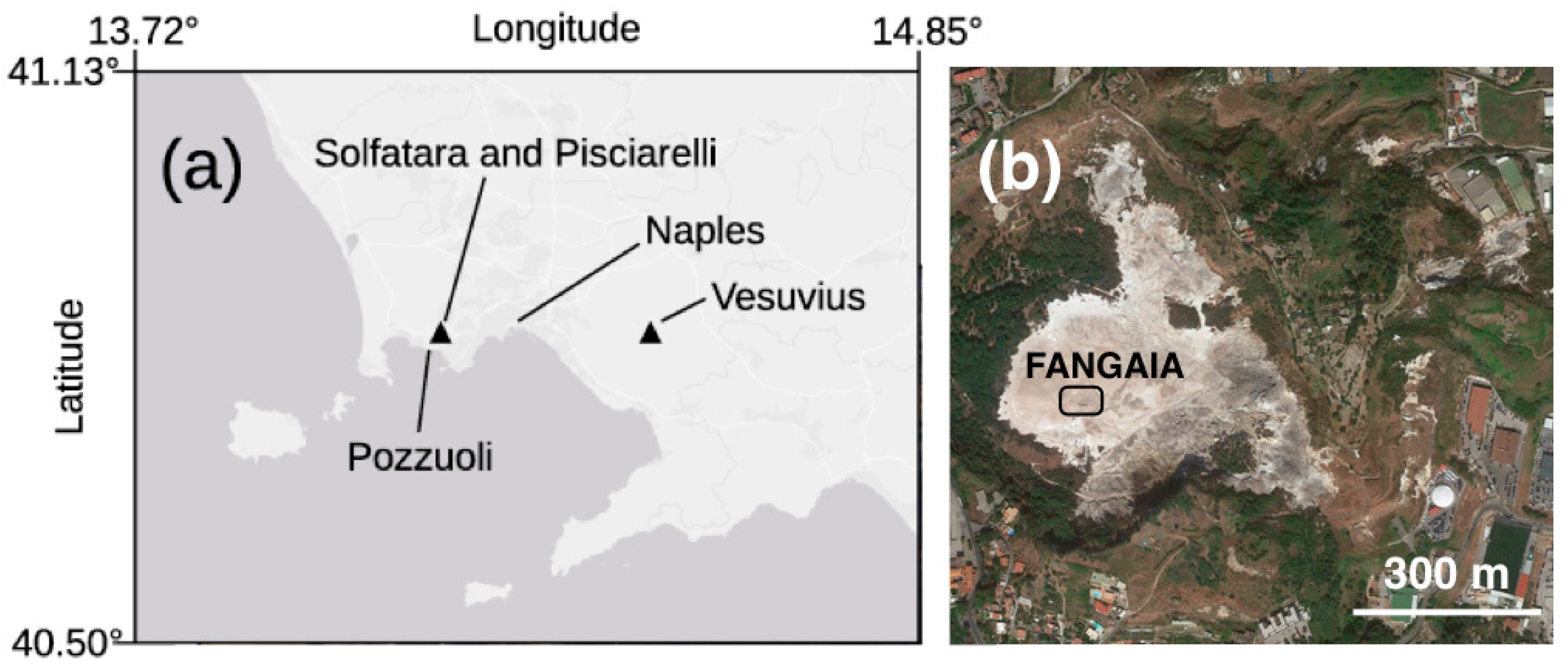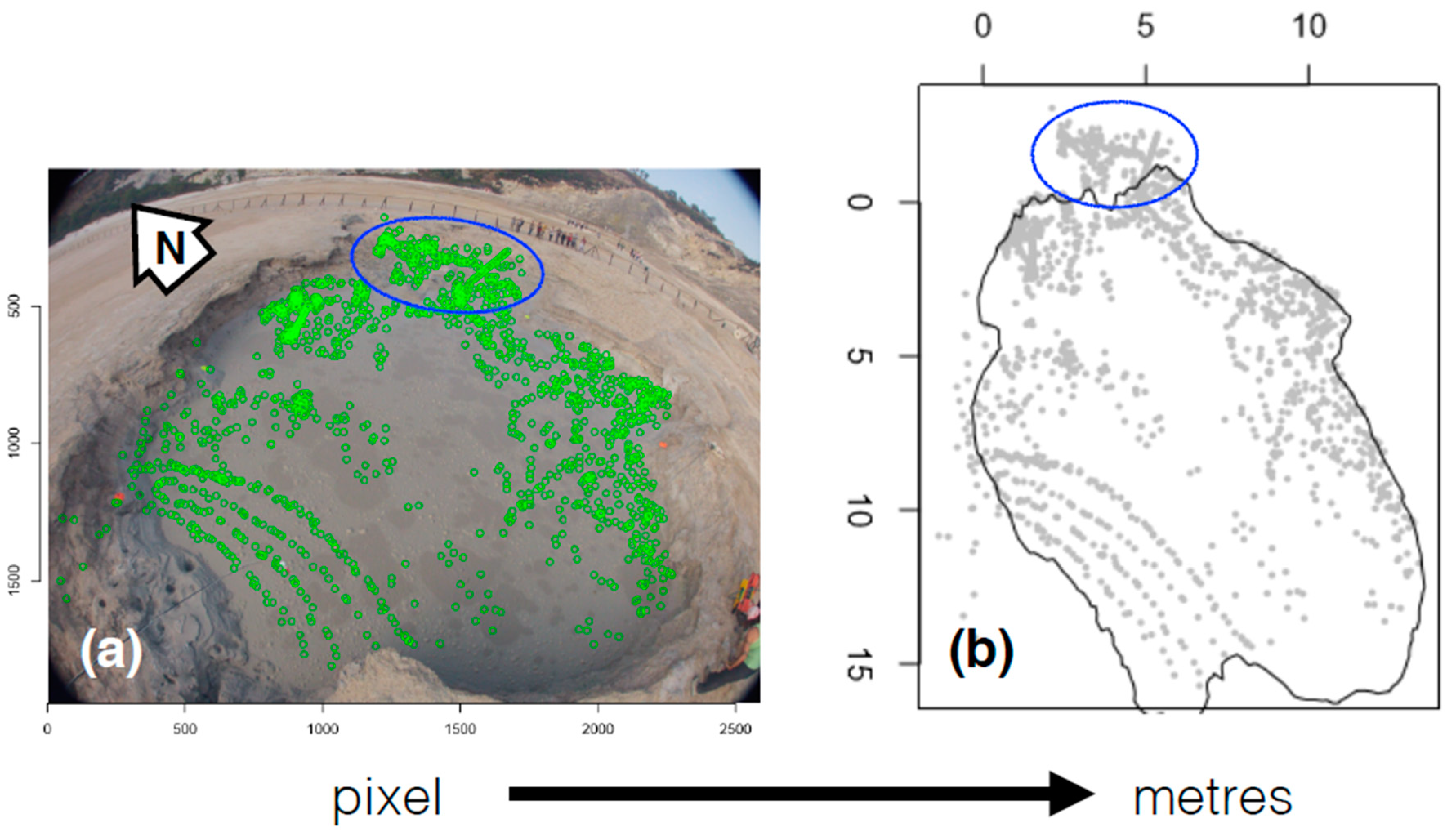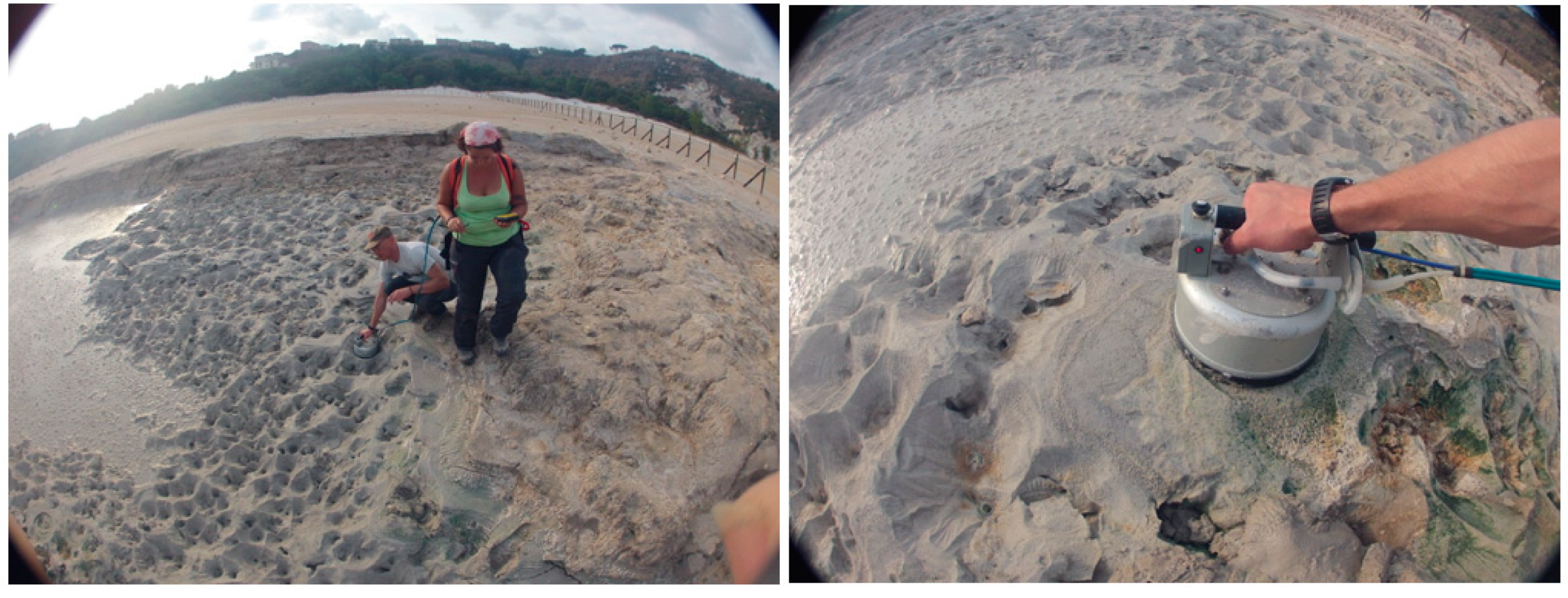CO2 and H2S Degassing at Fangaia Mud Pool, Solfatara, Campi Flegrei (Italy): Origin and Dynamics of the Pool Basin
Abstract
1. Introduction
2. Data Sources: Field, Laboratory and Desk Procedures
3. Discussion
3.1. CO2 and H2S Concentrations and CO2/H2S Ratios
3.2. CO2 and H2S Fluxes
3.3. Origin and Dynamics of the Fangaia Basin
4. Conclusive Remarks
Author Contributions
Funding
Acknowledgments
Conflicts of Interest
References
- Rouwet, D.; Tassi, F.; Mora-Amador, R.; Sandri, L.; Chiarini, V. Past, present and future of volcanic lake monitoring. J. Volcanol. Geotherm. Res. 2014, 272, 78–97. [Google Scholar] [CrossRef]
- Rouwet, D.; Ohba, T. Cl partitioning and isotopic fractionation during crater lake fluid cycling. In Volcanic Lakes; Rouwet, D., Christenson, B., Tassi, F., Vandemeulebrouck, J., Eds.; Springer: Heidelberg, Germany, 2015; pp. 179–200. [Google Scholar] [CrossRef]
- Shinohara, H.; Yoshikawa, S.; Miyabuchi, Y. Degassing activity of a volcanic crater lake: Volcanic plume measurements at the Yudamari crater lake, Aso volcano, Japan. In Volcanic Lakes; Advances of Volcanology IAVCEI Series; Springer: Heidelberg, Germany, 2015. [Google Scholar] [CrossRef]
- Tamburello, G.; Agusto, M.; Caselli, A.; Tassi, F.; Vaselli, O.; Calabrese, S.; Rouwet, D.; Capaccioni, B.; Di Napoli, R.; Cardellini, C.; et al. Intense magmatic degassing through the lake of Copahue volcano, 2013–2014. J. Geophys. Res. 2015. [Google Scholar] [CrossRef]
- Capaccioni, B.; Rouwet, D.; Tassi, F. HCl degassing from extremely acidic crater lakes: Empirical results from experimental determinations and implications for geochemical monitoring. In Geochemistry and Geophysics of Volcanic Lakes; Caudron, C., Capaccioni, B., Ohba, T., Eds.; Geological Society of London Special Publications: London, UK, 2017. [Google Scholar] [CrossRef]
- de Moor, J.M.; Aiuppa, A.; Pacheco, J.; Avard, G.; Kern, C.; Liuzzo, M.; Martínez, M.; Giudice, G.; Fischer, T.P. Short-period volcanic gas precursors to phreatic eruptions: Insights from Poás volcano, Costa Rica. Earth Planet. Sci. Lett. 2016, 442, 218–227. [Google Scholar] [CrossRef]
- de Moor, J.M.; Stix, J.; Avard, G.; Muller, C.; Corrales, E.; Diaz, J.A.; Alan, A.; Brenes, J.; Pacheco, J.; Aiuppa, A.; et al. Insights on hydrothermal-magmatic interactions and eruptive processes at Poás volcano (Costa Rica) from high-frequency gas monitoring and drone measurements. Geophys. Res. Lett. 2019, 46, 1293–1302. [Google Scholar] [CrossRef]
- Gunawan, H.; Caudron, C.; Pallister, J.; Primulyana, S.; Christenson, B.; McCausland, W.; van Hinsberg, V.; Lewicki, J.; Rouwet, R.; Kelly, P.; et al. New insights into Kawah Ijen’s volcanic system from the wet volcano workshop experiment. In Geochemistry and Geophysics of Volcanic Lakes; Caudron, C., Capaccioni, B., Ohba, T., Eds.; Geological Society of London Special Publications: London, UK, 2017. [Google Scholar] [CrossRef]
- Hasselle, N.; Rouwet, D.; Aiuppa, A.; Jácome-Paz, M.P.; Pfeffer, M.; Taran, Y.; Campion, R.; Bitetto, M.; Giudice, G.; Bergsson, B. Sulfur degassing from steam-heated crater lakes: El Chichón (Chiapas, Mexico) and Víti (Iceland). Geophys. Res. Lett. 2018, 45, 7504–7513. [Google Scholar] [CrossRef]
- Takano, B. Correlation of volcanic activity with sulfur oxyanion speciation in crater lake. Science 1987, 235, 1542–1712. [Google Scholar] [CrossRef]
- Symonds, R.B.; Gerlach, T.M.; Reed, M.H. Magmatic gas scrubbing: Implications for volcano monitoring. J. Volcanol. Geotherm. Res. 2001, 108, 303–341. [Google Scholar] [CrossRef]
- Kusakabe, M.; Komoda, Y.; Takano, B.; Abiko, T. Sulfur isotopic effects in the disproportionation reaction of sulfur dioxide in hydrothermal fluids: Implications for the δ34S variations of dissolved bisulfate and elemental sulfur from active crater lakes. J. Volcanol. Geotherm. Res. 2000, 97, 287–307. [Google Scholar] [CrossRef]
- Delmelle, P.; Bernard, A. The remarkable chemistry of sulfur in hyper-acid crater lakes: A scientific tribute to Bokuichiro Takano and Minoru Kusakabe. In Volcanic Lakes; Advances in Volcanology IAVCEI Series; Rouwet, D., Christenson, B., Tassi, F., Vandemeulebrouck, J., Eds.; Springer: Heidelberg, Germany, 2015. [Google Scholar] [CrossRef]
- Inguaggiato, C.; Pappaterra, S.; Peiffer, L.; Apollaro, C.; Brusca, L.; De Rosa, R.; Rouwet, D.; Caudron, C. Suparjan Mobility of REE from a hyperacid brine to secondary minerals precipitated in a volcanic hydrothermal system: Kawah Ijen crater lake (Java, Indonesia). Sci. Total Environ. 2020, 740. [Google Scholar] [CrossRef]
- Aiuppa, A.; Tamburello, G.; Di Napoli, R.; Cardellini, C.; Chiding, G.; Giudice, G.; Grassa, F.; Pedone, M. First observations of the fumarolic gas output from a restless caldera: Implications for the current period of unrest (2005–2013) at Campi Flegrei. Geochem. Geophys. Geosyst. 2013, 14, 4153–4169. [Google Scholar] [CrossRef]
- Pedone, M.; Aiuppa, A.; Giudice, G.; Grassa, F.; Cardellini, C.; Chiodini, G.; Valenza, M. Volcanic CO2 flux measurement at Campi Flegrei by tunable diode laser absorption spectroscopy. Bull. Volcanol. 2014, 76. [Google Scholar] [CrossRef]
- Aiuppa, A.; Fiorani, L.; Santoro, S.; Parracino, S.; Nuvoli, M.; Chiodini, G.; Minopoli, C.; Tamburello, G. New ground-based lidar enables volcanic CO2 flux measurements. Sci. Rep. 2015, 5. [Google Scholar] [CrossRef] [PubMed]
- Queißer, M.; Granieri, D.; Burton, M. A new frontier in CO2 flux measurements using a highly portable DIAL laser system. Sci. Rep. 2016, 6, 33834. [Google Scholar] [CrossRef]
- Cardellini, C.; Chiodini, G.; Frondini, F.; Avino, R.; Bagnato, E.; Caliro, S.; Lelli, M.; Rosiello, A. Monitoring diffuse volcanic degassing during volcanic unrests: The case of Campi Flegrei (Italy). Sci. Rep. 2017, 7, 6757. [Google Scholar] [CrossRef]
- Chiodini, G.; Vandemeulebrouck, J.; Caliro, S.; D’Auria, L.; De Martino, P.; Mangiacapra, A.; Petrillo, Z. Evidence of thermal-driven processes triggering the 2005–2014 unrest at Campi Flegrei caldera. Earth Planet. Sci. Lett. 2015, 414, 58–67. [Google Scholar] [CrossRef]
- Chiodini, G.; Giudicepietro, F.; Vandemeulebrouck, J.; Aiuppa, A.; Caliro, S.; De Cesare, W.; Tamburello, G.; Avino, R.; Orazi, M.; D’Auria, L. Fumarolic tremor and geochemical signals during a volcanic unrest. Geology 2017, 45, 1131–1134. [Google Scholar] [CrossRef]
- Tamburello, G.; Caliro, S.; Chiodini, G.; De Martino, P.; Avino, R.; Minopoli, C.; Carandente, A.; Rouwet, D.; Aiuppa, A.; Costa, A.; et al. Escalating CO2 degassing at the Pisciarelli fumarolic system, and implications for the ongoing Campi Flegrei unrest. J. Volcanol. Geotherm. Res. 2019, 384, 151–157. [Google Scholar] [CrossRef]
- Caliro, S.; Chiodini, G.; Moretti, R.; Avino, R.; Granieri, D.; Russo, M.; Fiebig, J. The origin of the fumaroles of La Solfatara (Campi Flegrei, South Italy). Geochim. Cosmochim. Acta 2007, 71. [Google Scholar] [CrossRef]
- Giggenbach, W.F. Redox processes governing the chemistry of fumarolic discharges from White Island, New Zealand. Appl. Geochem. 1987, 2, 143–161. [Google Scholar] [CrossRef]
- Bruno, P.P.G.; Ricciardi, G.P.; Petrillo, Z.; Di Fiore, V.; Troiano, A.; Chiodini, G. Geophysical and hydrogeological experiments from a shallow hydrothermal system at Solfatara Volcano, Campi Flegrei, Italy: Response to caldera unrest. J. Geophys. Res. 2007, 112, B06201. [Google Scholar] [CrossRef]
- Gresse, M.; Vandemeulebrouck, J.; Byrdina, S.; Chiodini, G.; Revil, A.; Johnson, T.C.; Ricci, T.; Vilardo, G.; Mangiacapra, A.; Lebourg, T.; et al. Three-dimensional electrical resistivity tomography of the Solfatara Crater (Italy): Implications for the multiphase flow structure of the shallow hydrothermal system. J. Geophys. Res. Solid Earth 2017, 122, 8749–8768. [Google Scholar] [CrossRef]
- Montanaro, C.; Mayer, K.; Isaia, R.; Gresse, M.; Scheu, B.; Yilmaz, T.I.; Vandemeulebrouck, J.; Ricci, T.; Dingwell, D.B. Hydrothermal activity and subsoil complexity: Implication for degassing processes at Solfatara crater, Campi Flegrei. Bull. Volcanol. 2017. [Google Scholar] [CrossRef]
- Aiuppa, A.; D’Alessandro, W.; Federico, C.; Palumbo, B.; Valenza, M. The aquatic geochemistry of arsenic in volcanic groundwaters from southern Italy. Appl. Geochem. 2003, 18, 1283–1296. [Google Scholar] [CrossRef]
- Tamburello, G. Ratiocalc: Software for processing data from multicomponent volcanic gas analyzers. Comput. Geosci. 2015, 82, 63–67. [Google Scholar] [CrossRef]
- Available online: https://www.ivhhn.org/information/information-different-volcanic-gases (accessed on 23 November 2020).
- Chiodini, G.; Cioni, R.; Guidi, M.; Raco, B.; Marini, L. Soil CO2 flux measurements in volcanic and geothermal areas. Appl. Geochem. 1998, 13, 543–552. [Google Scholar] [CrossRef]
- Tamburello, G.; Aiuppa, A.; Kantzas, E.P.; McGonigle, A.J.S.; Ripepe, M. Passive vs. active degassing modes at an open-vent volcano (Stromboli, Italy). Earth Planet. Sci. Lett. 2012, 359–360, 106–116. [Google Scholar] [CrossRef]
- Delle Donne, D.; Tamburello, G.; Aiuppa, A.; Bitetto, M.; Lacanna, G.; D’Aleo, R.; Ripepe, M. Exploring the explosive-effusive transition using permanent ultraviolet cameras. J. Geophys. Res. Solid Earth 2017, 122, 4377–4394. [Google Scholar] [CrossRef]








Publisher’s Note: MDPI stays neutral with regard to jurisdictional claims in published maps and institutional affiliations. |
© 2020 by the authors. Licensee MDPI, Basel, Switzerland. This article is an open access article distributed under the terms and conditions of the Creative Commons Attribution (CC BY) license (http://creativecommons.org/licenses/by/4.0/).
Share and Cite
Rouwet, D.; Tamburello, G.; Ricci, T.; Sciarra, A.; Capecchiacci, F.; Caliro, S. CO2 and H2S Degassing at Fangaia Mud Pool, Solfatara, Campi Flegrei (Italy): Origin and Dynamics of the Pool Basin. Minerals 2020, 10, 1051. https://doi.org/10.3390/min10121051
Rouwet D, Tamburello G, Ricci T, Sciarra A, Capecchiacci F, Caliro S. CO2 and H2S Degassing at Fangaia Mud Pool, Solfatara, Campi Flegrei (Italy): Origin and Dynamics of the Pool Basin. Minerals. 2020; 10(12):1051. https://doi.org/10.3390/min10121051
Chicago/Turabian StyleRouwet, Dmitri, Giancarlo Tamburello, Tullio Ricci, Alessandra Sciarra, Francesco Capecchiacci, and Stefano Caliro. 2020. "CO2 and H2S Degassing at Fangaia Mud Pool, Solfatara, Campi Flegrei (Italy): Origin and Dynamics of the Pool Basin" Minerals 10, no. 12: 1051. https://doi.org/10.3390/min10121051
APA StyleRouwet, D., Tamburello, G., Ricci, T., Sciarra, A., Capecchiacci, F., & Caliro, S. (2020). CO2 and H2S Degassing at Fangaia Mud Pool, Solfatara, Campi Flegrei (Italy): Origin and Dynamics of the Pool Basin. Minerals, 10(12), 1051. https://doi.org/10.3390/min10121051




